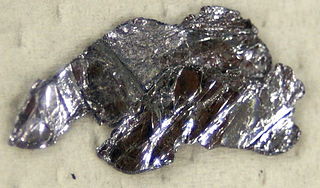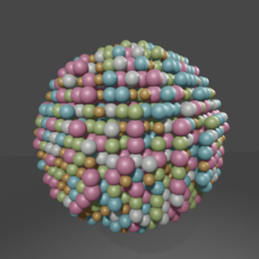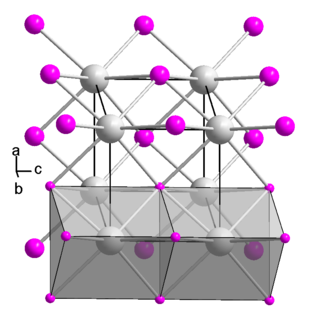Related Research Articles

Molybdenum disulfide is an inorganic compound composed of molybdenum and sulfur. Its chemical formula is MoS
2.
Technetium compounds are chemical compounds containing the chemical element technetium. Technetium can form multiple oxidation states, but often forms in the +4 and +7 oxidation states. Because technetium is radioactive, technetium compounds are extremely rare on Earth.

Michael Stanley Whittingham is a British-American chemist. He is a professor of chemistry and director of both the Institute for Materials Research and the Materials Science and Engineering program at Binghamton University, State University of New York. He also serves as director of the Northeastern Center for Chemical Energy Storage (NECCES) of the U.S. Department of Energy at Binghamton. He was awarded the Nobel Prize in Chemistry in 2019 alongside Akira Yoshino and John B. Goodenough.

Mercury(I) sulfate, commonly called mercurous sulphate (UK) or mercurous sulfate (US) is the chemical compound Hg2SO4. Mercury(I) sulfate is a metallic compound that is a white, pale yellow or beige powder. It is a metallic salt of sulfuric acid formed by replacing both hydrogen atoms with mercury(I). It is highly toxic; it could be fatal if inhaled, ingested, or absorbed by skin.
Molybdenum dioxide is the chemical compound with the formula MoO2. It is a violet-colored solid and is a metallic conductor. The mineralogical form of this compound is called tugarinovite, and is only very rarely found.

Lithium iron phosphate or lithium ferro-phosphate (LFP) is an inorganic compound with the formula LiFePO
4. It is a gray, red-grey, brown or black solid that is insoluble in water. The material has attracted attention as a component of lithium iron phosphate batteries, a type of Li-ion battery. This battery chemistry is targeted for use in power tools, electric vehicles, solar energy installations and more recently large grid-scale energy storage.
An Ion gel is a composite material consisting of an ionic liquid immobilized by an inorganic or a polymer matrix. The material has the quality of maintaining high ionic conductivity while in the solid state. To create an ion gel, the solid matrix is mixed or synthesized in-situ with an ionic liquid. A common practice is to utilize a block copolymer which is polymerized in solution with an ionic liquid so that a self-assembled nanostructure is generated where the ions are selectively soluble. Ion gels can also be made using non-copolymer polymers such as cellulose, oxides such as silicon dioxide or refractory materials such as boron nitride.
Bernt Krebs is a German scientist. He is conducting research at the Faculty of Chemistry, University of Münster.
A potassium-ion battery or K-ion battery is a type of battery and analogue to lithium-ion batteries, using potassium ions for charge transfer instead of lithium ions. It was invented by the Iranian/American chemist Ali Eftekhari in 2004.

NASICON is an acronym for sodium (Na) super ionic conductor, which usually refers to a family of solids with the chemical formula Na1+xZr2SixP3−xO12, 0 < x < 3. In a broader sense, it is also used for similar compounds where Na, Zr and/or Si are replaced by isovalent elements. NASICON compounds have high ionic conductivities, on the order of 10−3 S/cm, which rival those of liquid electrolytes. They are caused by hopping of Na ions among interstitial sites of the NASICON crystal lattice.
The phosphidosilicates or phosphosilicides are inorganic compounds containing silicon bonded to phosphorus and one or more other kinds of elements. In the phosphosilicates each silicon atom is surrounded by four phosphorus atoms in a tetrahedron. The triphosphosilicates have a SiP3 unit, that can be a planar triangle like carbonate CO3. The phosphorus atoms can be shared to form different patterns e.g. [Si2P6]10− which forms pairs, and [Si3P7]3− which contains two-dimensional double layer sheets. [SiP4]8− with isolated tetrahedra, and [SiP2]2− with a three dimensional network with shared tetrahedron corners. SiP clusters can be joined, not only by sharing a P atom, but also by way of a P-P bond. This does not happen with nitridosilicates or plain silicates.
Larry A. Curtiss is an American chemist and researcher. He is a distinguished fellow and group leader of the Molecular Materials Group in the Materials Science Division at the U.S. Department of Energy’s (DOE) Argonne National Laboratory. In addition, Curtiss is a senior investigator in the Joint Center for Energy Storage Research (JCESR), a DOE Energy Storage Hub, and was the deputy director of the Center for Electrochemical Energy Science, a DOE Energy Frontier Research Center.

A solid-state electrolyte (SSE) is a solid ionic conductor and electron-insulating material and it is the characteristic component of the solid-state battery. It is useful for applications in electrical energy storage (EES) in substitution of the liquid electrolytes found in particular in lithium-ion battery. The main advantages are the absolute safety, no issues of leakages of toxic organic solvents, low flammability, non-volatility, mechanical and thermal stability, easy processability, low self-discharge, higher achievable power density and cyclability. This makes possible, for example, the use of a lithium metal anode in a practical device, without the intrinsic limitations of a liquid electrolyte thanks to the property of lithium dendrite suppression in the presence of a solid-state electrolyte membrane. The use of a high capacity anode and low reduction potential, like lithium with a specific capacity of 3860 mAh g−1 and a reduction potential of -3.04 V vs SHE, in substitution of the traditional low capacity graphite, which exhibits a theoretical capacity of 372 mAh g−1 in its fully lithiated state of LiC6, is the first step in the realization of a lighter, thinner and cheaper rechargeable battery. Moreover, this allows the reach of gravimetric and volumetric energy densities, high enough to achieve 500 miles per single charge in an electric vehicle. Despite the promising advantages, there are still many limitations that are hindering the transition of SSEs from academia research to large-scale production, depending mainly on the poor ionic conductivity compared to that of liquid counterparts. However, many car OEMs (Toyota, BMW, Honda, Hyundai) expect to integrate these systems into viable devices and to commercialize solid-state battery-based electric vehicles by 2025.

High-entropy-alloy nanoparticles (HEA-NPs) are nanoparticles having five or more elements alloyed in a single-phase solid solution structure. HEA-NPs possess a wide range of compositional library, distinct alloy mixing structure, and nanoscale size effect, giving them huge potential in catalysis, energy, environmental, and biomedical applications.

Lithium aluminium germanium phosphate, typically known with the acronyms LAGP or LAGPO, is an inorganic ceramic solid material whose general formula is Li
1+xAl
xGe
2-x(PO
4)
3. LAGP belongs to the NASICON family of solid conductors and has been applied as a solid electrolyte in all-solid-state lithium-ion batteries. Typical values of ionic conductivity in LAGP at room temperature are in the range of 10–5 - 10–4 S/cm, even if the actual value of conductivity is strongly affected by stoichiometry, microstructure, and synthesis conditions. Compared to lithium aluminium titanium phosphate (LATP), which is another phosphate-based lithium solid conductor, the absence of titanium in LAGP improves its stability towards lithium metal. In addition, phosphate-based solid electrolytes have superior stability against moisture and oxygen compared to sulfide-based electrolytes like Li
10GeP
2S
12 (LGPS) and can be handled safely in air, thus simplifying the manufacture process. Since the best performances are encountered when the stoichiometric value of x is 0.5, the acronym LAGP usually indicates the particular composition of Li
1.5Al
0.5Ge
1.5(PO
4)
3, which is also the typically used material in battery applications.
Arsenide bromides or bromide arsenides are compounds containing anions composed of bromide (Br−) and arsenide (As3−). They can be considered as mixed anion compounds. They are in the category of pnictidehalides. Related compounds include the arsenide chlorides, arsenide iodides, phosphide bromides, and antimonide bromides.

Europium compounds are compounds formed by the lanthanide metal europium (Eu). In these compounds, europium generally exhibits the +3 oxidation state, such as EuCl3, Eu(NO3)3 and Eu(CH3COO)3. Compounds with europium in the +2 oxidation state are also known. The +2 ion of europium is the most stable divalent ion of lanthanide metals in aqueous solution. Many europium compounds fluoresce under ultraviolet light due to the excitation of electrons to higher energy levels. Lipophilic europium complexes often feature acetylacetonate-like ligands, e.g., Eufod.

Terbium compounds are compounds formed by the lanthanide metal terbium (Tb). Terbium generally exhibits the +3 oxidation state in these compounds, such as in TbCl3, Tb(NO3)3 and Tb(CH3COO)3. Compounds with terbium in the +4 oxidation state are also known, such as TbO2 and BaTbF6. Terbium can also form compounds in the 0, +1 and +2 oxidation states.

Molybdenum monophosphide is a binary inorganic compound of molybdenum metal and phosphorus with the chemical formula MoP.
Molybdenum diphosphide is a binary inorganic compound of molybdenum metal and phosphorus with the chemical formula MoP2.
References
- ↑ Kondori, Alireza; Esmaeilirad, Mohammadreza; Baskin, Artem; Song, Boao; Wei, Jialiang; Chen, Wei; Segre, Carlo U.; Shahbazian‐Yassar, Reza; Prendergast, David; Asadi, Mohammad (June 2019). "Identifying Catalytic Active Sites of Trimolybdenum Phosphide (Mo 3 P) for Electrochemical Hydrogen Evolution". Advanced Energy Materials . 9 (22). doi:10.1002/aenm.201900516. ISSN 1614-6832 . Retrieved 9 March 2024.
- ↑ Muchharla, Baleeswaraiah; Malali, Praveen; Daniel, Brenna; Kondori, Alireza; Asadi, Mohammad; Cao, Wei; Elsayed-Ali, Hani E.; Castro, Mickaël; Elahi, Mehran; Adedeji, Adetayo; Sadasivuni, Kishor Kumar; Maurya, Muni Raj; Kumar, Kapil; Karoui, Abdennaceur; Kumar, Bijandra (13 September 2021). "Tri-molybdenum phosphide (Mo3P) and multi-walled carbon nanotube junctions for volatile organic compounds (VOCs) detection". Applied Physics Letters . 119 (11). doi:10.1063/5.0059378.
- ↑ Donnay, Joseph Désiré Hubert (1973). Crystal Data: Inorganic compounds. National Bureau of Standards. p. 16. Retrieved 9 March 2024.
- ↑ Mellor, Joseph William (1971). Supplement to Mellor's Comprehensive Treatise on Inorganic and Theoretical Chemistry: suppl. 1, pt. 1. N. Longmans, Green and Company. p. 337. Retrieved 9 March 2024.
- ↑ Kondori, Alireza; Esmaeilirad, Mohammadreza; Baskin, Artem; Song, Boao; Wei, Jialiang; Chen, Wei; Segre, Carlo U.; Shahbazian‐Yassar, Reza; Prendergast, David; Asadi, Mohammad (June 2019). "Identifying Catalytic Active Sites of Trimolybdenum Phosphide (Mo 3 P) for Electrochemical Hydrogen Evolution". Advanced Energy Materials . 9 (22). doi:10.1002/aenm.201900516 . Retrieved 9 March 2024.
- ↑ Kuei, Brooke (August 27, 2019). "Uncovering the Origin of High Performance in a New Water Splitting Catalyst". foundry.lbl.gov. Retrieved 9 March 2024.
- ↑ Timmer, John (6 February 2023). "New battery seems to offer it all: Lithium-metal/lithium-air electrodes". Ars Technica . Retrieved 9 March 2024.
- ↑ "(201d) First-Principles Study of Lithium-Air Batteries Based on Tri-Molybdenum Phosphide (Mo3P) Nanoparticles | AIChE". aiche.org. Retrieved 9 March 2024.